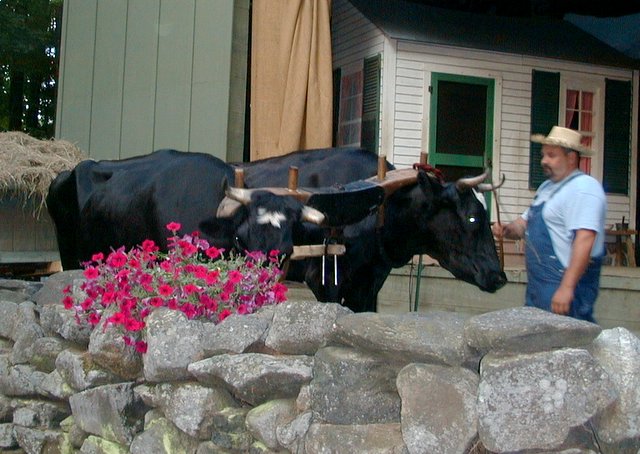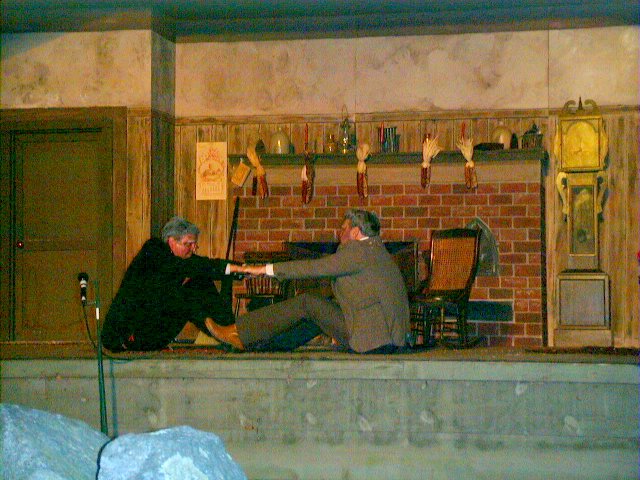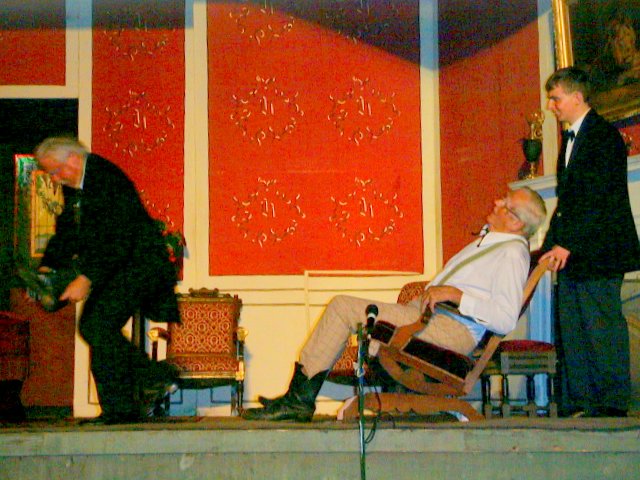History
Denman Thompson

Henry Denman Thompson(October 15, 1833 - April 14, 1911) was an American playwright and theater actor. Denman Thompson was a direct descendent of one of the original colonists, to whom the township of Swanzey (Lower Ashuelot) was granted by the Colonial authorities of Massachusetts in 1735. But his father, Captain Rufus Thompson moved his family to a settlement in western Pennsylvania near Lake Erie in 1831. It was called Beechwood, what is now Girard, PA. That is where Denman Thompson was born in 1833. His family would move back to Swanzey when he was 14 years old.
It is here that he would start to learn his fathers trade of carpentry and attend the Mt. Caesar Seminary. For only three short years Denman would live amoungst the yankee characters that he would make famous 3 decades later. Denman got restless when he was 17 years old, and in 1850, persuaded his folks to let him go to Boston to seek his fortune.
He first got work with a circus where he had charge of the banners and poles and rode in the opening pageant, and, after some instruction, took his place among the acrobats and tumblers. After the circus he took jobs as a stagehand, doorman and ended up at the store of his Uncle, D.D. Baxter in Lowell. Tiring of that he went back to the stage and landed his first speaking part in the "French Spy". That was in 1852 and he was behind the footlights ever since.
In 1854 Denman Thompson moved to Toronto, Canada to train at the Royal Lyceum Theater. In 1860, he married Maria Bolton, with whom he had three children Vene, Annie, and Franklin. Denman was making a modest living on his acting career but, in the 1870's he started writing a small sketch about the down to earth characters he remembered back in Swanzey. The sketch entitled "Joshua Whitcomb" was barely 25 minutes long when he started performing it. It would grow to three acts and would earn Denman enough money to build his large house back in Swanzey. Denman attributes J. M. Hill for giving him the advice to develop the play "The Old Homestead".
Thompson along with George Ryer wrote the four act play "The Old Homestead". It opened in April of 1886 at the Boston Theater where the first weeks receipts were $11,279.25. With Thompson in the lead role the production proved to be very successful and made Denman Thompson a wealthy man. He toured with the play throughout the United States, and debuted with it on Broadway in 1904, and returned as a revival in 1907. In 1915, after his passing, it was made into a motion picture of the same name by the Famous Players Film Company.
Thompson wrote other plays, including some collaborative efforts with George W. Ryer, of which several were made into motion pictures. Their 1886 Broadway play became the basis for the 1926 film "Sunshine of Paradise Alley", as was the case with their 1903 Broadway production of"Our New Minister," which became the basis for the 1913 Kalem Company film starring Alice Joyce and Tom Moore. In 1914, the Kalem Company also made the highly successful adventure film serial, "The Hazards of Helen", based on Thompson's work.
Denman Thompson died in 1911 at his home in West Swanzey, New Hampshire
Denman Thompson and The Old Homestead
"THE OLD HOMESTEAD" --the greatest play the world has ever laughed and wept over--an enduring classic beloved of generation after generation--will forever stand as a monument to its creator, Denman Thompson. "The Old Homestead" had its world premiere at the Boston Theatre in April, 1886 and from the moment the curtain went up there was never a question about its success. In writing "The Old Homestead," Mr. Thompson combined the lives of several of the people that he knew in Swanzey, taking the characteristics of each to make the unique character presented. "Uncle Joshua Whitcomb" is a combination of Joshua Holbrook and Captain Otis Whitcomb. The real Uncle Joshua, with his brother, Aaron and sister, Rhoda -- "Aunt Matilda" of the play lived on the old Holbrook Farm. Aunt Rhoda was the tailoress for the neighborhood, going from house to house with her outfit early and late to supply the demands of her customers with new coats and suits. Following the death of Aunt Rhoda the Holbrook Farm passed into other hands. Joyce Kilmer wrote the poem "Trees" while a guest at the Holbrook Farm.
"Cy Prime," the bashful lover in the play, lived near the Holbrook Farm, and it would be strange if some part of this love romance were not true, for what would have been more natural than for him to tire of his lonely life and look with longing eyes toward the thrifty Rhoda, but, lacking the courage of his convictions, he died with his secret untold.

"Seth Perkins," "Rickety Ann" and "Eb Ganzey" were imaginary characters, whose laughable antics are so woven in with the acts of the others that the group is made complete.
The play "The Old Homestead" was a great financial success, but it is not in this way alone that its success is measured. An evening's visit to the theatre witnessing this play has been the turning point in the life of many -- one young man in a western city who had neglected to write to his parents in the East wrote to Mr. Thompson saying: --"When I saw the great anxiety of the father for his son, I cried like a child and I went straight to the hotel and wrote him, and I am going to write every week of my life. You know I was raised in the country and the play took me back to my old homestead."
Another young man living in Chicago, by his own statement was a "Bum." "The Old Homestead" was playing in Chicago, passing the theatre he was attracted by the poster at the entrance. He found just money enough in his pocket to get in.
When "Uncle Josh" befriended the tramp and gave him money to go home and the words "Go home' and try to be somebody -- you are a young man yet -- it ain't too late." The story goes he went home and became a respectable citizen. He was in Keene in later years and told the story. He went to a florist shop and purchased flowers and took them to the cemetery in West Swanzey and placed them on the grave of Denman Thompson ~ the "Uncle Josh" in the play. A man he never met personally but whose words made a man of him.
Denman Thompson toured year after year, playing the leading role in his play, and the name "The Old Homestead" became a household word from Maine to California.
In a word, "The Old Homestead" epitomizes not merely the New England in which its scenes are laid, but the nation as well. It stands for those rugged qualities that have made this nation great. It stands for all that is clean and worth-while in our life. --From the archives of The Old Homestead Association.
This year's performances are Friday, Saturday and Sunday, July 16, 17 and 18, 2010. All performances start at 7:30 p.m. Tickets are $8.00 at the gate.
Swanzey Revival
The In 1936 North Swanzey was in great need of a building to be used as a social center. The North Swanzey Community Association was formed and a small house purchased with money earned from a pageant, taken from the history of Swanzey, called "The Blazing Arrow". The men and women started to rebuild the house, but wishing to pay off the mortgage and enlarge the building, the idea was suggested to put on the play "The Old Homestead," written by a Swanzey man and to be presented by Swanzey players. The idea was discussed and realizing that it was too big an undertaking for one group it was suggested that the First Congregational Church be asked to join - hoping to be able to pay off both mortgages! This they did - and the revival began.
Work was started on the pine fringed lot on the Carpenter lot - a steeply sloping hill that would become a natural outdoor amphitheartre. Men from all parts of Swanzey worked evenings and Saturdays and Sundays clearing the land. Carpenters built the big open front stage, using salvaged lumber. For months everyone worked with axes and scythes. Space for the seats was planned and one neighbor with a saw rig furnished power for cutting the posts on which the first rough board seats were placed. Others set up an outdoor lighting system at the top of the hill on a staging thirty-five feet above the ground to hold two huge batteries of thirteen special floodlights, giving thirty-million candlepower to illumunate the stage.
The women of the community helped too - serving the men with donuts and coffee, wielding a paint brush, pulling nails and others driving nails. Later they hunted the attics and borrowed clothes to be made over to fit each part; cleaned, pressed and made new costumes, all as near the original costumes as possible.
Many of the original properties were borrowed at first - the ottoman and the hangings in the second act, the church drop, Uncle Josh's coat in Act two, Eb Ganzey's hat in the first act, Cy Prime's cane and the tambourine used in the Salvation Army scene. Later the Association was able to purchase the original properties used by Denman Thompson from Mrs. Horton, whose husband had carried on the show for several years after Denman Thompson was no longer able to play the part. The original script of "The Old Homestead" was given to the Association in 1947 by Anita Kilpatrick snd Mrs. Thomas B. Holmes, granddaudhters of Denman Thompson.
The first revival of "The Old Homestead" by the Swanzey Players was in 1939. On the first night a thunder shower came, but about 7:45 pm the sun broke through. Girl and Boy Scouts put newspapers on the seats, the make-up crew went to work, as did everyone else - and the show went on, only a little late! The performance amazed the critics. "The Old Homestead" was presented three more years and postponed during World War II. The play was presented again in 1946 and has been revived each year since by the Swanzey Players.
E.P. Barrett reprinted from souvenir program
The Potash Bowl and Vicinity
Many people have perhaps wondered why this amphitheater is called the Potash Bowl. During the early part of the nineteenth century and possibly earlier much of the business of the general stores was by barter and one of the items taken in trade was wood ashes. As early as 1800 the proprietor of one of these stores in Swanzey, advertised in the New Hampshire Sentinel that he would pay 1s 6d for good wood ashes or would allow that much in trade for English and West India goods such as West India rum at 5s 11 pence per gallon, sugar, 7 pounds for 6s, and other articles in proportion.

The ashes taken in trade by at least one of these stores near this amphitheater were stored here, and later processed in huge iron kettles to produce potash, lye, etc. for making soap and other uses. Part was used here and the rest sent to Boston.
It was therefore due to the early use of this site and to its natural contour that it was thought fitting to call it the Potash Bowl.
The old road that passed by the Potash Bowl, once known as the Boston Road, was at one time the most traveled road in Cheshire County. Most of the travel from this section of the state as well as much of Vermont going to Boston passed over this road. Due to this heavy travel there were at various times as many as eight places in Swanzey Center used as hotels or inns for entertaining the traveling public. The last building used as a hotel was on the site of the present Grange Hall adjacent to the Potash Bowl.
Near the Potash Bowl, to the west of the Carpenter Home, is the site of the first church or meeting house which was built around 1764-5. Before it was entirely completed it was damaged by the hurrucane of 1765. Tradition says that the members of the church council holding a meeting in the church had hardly left the building when the hurricane passed and turned the building one quarter turn, so that it was made to face the east instead of the south.
The Mt. Caesar Union Library across from the Potash Bowl was formerly the Mt. Caesar Seminary and Swanzey Acadamy which was founded in 1843. It flourished for several years and many of its students later became prominent in the industrial and educational life of this country. It is here on the small stage on the third floor that Denman Thompson acted in his first shows.
The fields to the east and south (now the Monadnock Regional High School and The Mt. Caesar Elementary School) were used for military musters during that period when all able-bodied men from 18-40 were required to serve in the militia. At one muster in 1810 as many as four thousand troups participated.
Leon A. Woodward --reprinted from 1955 Souvenir Program
Josh: "Well, I must look all fired green when folks think I'm on my way to the Centennial, a year after it is over. I did not go there at all; wish I had now; they say it was worth seeing. I bet a ninepence I don't miss the next one!"
